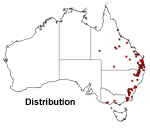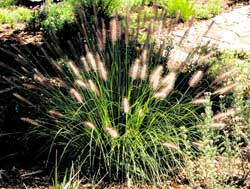Cenchrus purpurascens
Swamp Foxtail
Cenchrus purpurascens Thunb.
[Synonym: Pennisetum alopecuroides (L.) Spreng.]Cenchrus purpurascens, commonly known as Swamp Foxtail or Fountain Grass, belongs to the grass family Poaceae.
 As
the common name reveals, C. purpurascens naturally occurs in moist conditions
in flats below watercourses and in boggy areas. Its distribution ranges from
tropical Queensland to the south of New South Wales mainly along the coast.
As
the common name reveals, C. purpurascens naturally occurs in moist conditions
in flats below watercourses and in boggy areas. Its distribution ranges from
tropical Queensland to the south of New South Wales mainly along the coast.
C. purpurascens is a tufted or clump-forming grass; that means it does not spread by underground shoots. It has graciously arching leaves that grow to 80 cm long and bears feathery mostly purplish flowerheads on 60- 100 cm long erect stems. The inflorescence can be up to 14 cm in length and resembles a foxtail, hence its common name.
The slender arching leaves create a linear texture and scale that contrasts other growth forms and adds character to every garden or landscape.
C. purpurascens changes its appearance and colour throughout the growing season showing an interesting aspect even when the peak flowering time of other plants has ceased. Usually the plant turns yellow in autumn after flowering. The grass has a luminous or translucent character, particularly when the sun stands low in the sky.
This ornamental grass is frost hardy to about – 7° C and grows in most soils even poorly drained soils. It is best grown in full sun or nearly so.
C. purpurascens will propagate well from fresh seed and a most unified germination can be achieved if the seeds are soaked in water before sowing.
It will take one to two weeks for complete germination. The seedlings can then be pricked out into pots for further cultivation until they are ready for planting. It is important to keep the soil moist during cultivation of the seedlings.
Division of the root is another effective method for propagation. The root is cut up into sections containing several shoots and potted or possibly planted out in the garden bed. This method is to be used if identical reproductions of cultivars are wanted.
Both methods are preferably done in early spring, although the seeds can be sown all year if the temperatures for germination can be realised.
The grass is a vigorous grower but responds well to fertilisation. The Botanic Gardens use a standard slow release fertiliser low in phosphorus in the potting mix or liquid fertiliser during cultivation.
Once the grass is planted out it generally does not require fertilisation as too many nutrients may suppress inflorescence production. The plants are maintained by cutting back the old foliage in early spring by about two thirds of its length.
Flowering time is in summer from January to June. The inflorescences are valuable in flower arrangements.
C. purpurascens can be used in many garden situations such as rockeries, bogs, near ponds and as groundcover.
In Australia there has been some speculation that C. purpurascens was possibly not native and may have weed potential. This seems to have been due to taxonomic confusion between Cenchrus purpurascens and C. setaceus (Fountain Grass). The latter is an African and Middle Eastern species that has become naturalised in several states and territories of Australia and elsewhere in the world as a weed. The distinctions between C. setaceus and other similar species are outlined in the Weeds of Australia key here:
http://keyserver.lucidcentral.org/weeds/data/media/Html/cenchrus_setaceus.htm
Original text by Petra Wilhelm (Botanical Intern 2003); subsequently updated online
References
Flora of Australia Volume 44, Poaceae 2 (2002). Melbourne ABRS/CSIRO Australia
Romanowski, N. (1993) Grasses and Bamboos and Related Plants in Australia.
Sharp, D. & Simon, K. S. (2002) AusGrass: Grasses of Australia. ABRS Identification Series.
Wrigley, J. & Fagg (1996) Australian Native Plants. Propagation, cultivation and use in landscaping.
Darke, R. (1999) The colour encyclopedia of Ornamental Grasses
![An Australian Government Initiative [logo]](/images/austgovt_brown_90px.gif)


